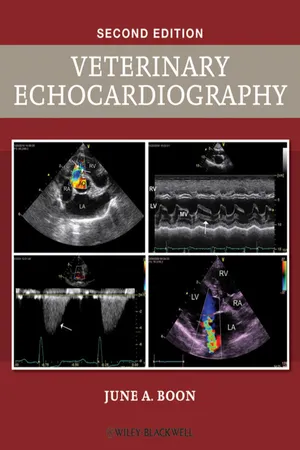
- English
- ePUB (mobile friendly)
- Available on iOS & Android
Veterinary Echocardiography
About this book
Veterinary Echocardiography, Second Edition is a fully revised version of the classic reference for ultrasound of the heart, covering two-dimensional, M-mode, and Doppler examinations for both small and large animal domestic species. Written by a leading authority in veterinary echocardiography, the book offers detailed guidelines for obtaining and interpreting diagnostic echocardiograms in domestic species. Now thoroughly updated to address advances in technology, including better transducers, tissue harmonic imaging, better color flow mapping, and color and spectral tissue Doppler imaging, this second edition provides an authoritative, comprehensive resource for echocardiographers of all levels of experience.
The Second Edition has been restructured to be more user-friendly, with chapters on acquired and congenital heart diseases broken down into shorter disease-specific chapters. Key changes include the addition of normal tissue Doppler technique, as well as five new appendices, covering topics such as normal reference ranges and an exam checklist. Veterinary Echocardiography, Second Edition builds on the success of the previous edition to provide complete information on obtaining echocardiograms in veterinary medicine.
Frequently asked questions
- Essential is ideal for learners and professionals who enjoy exploring a wide range of subjects. Access the Essential Library with 800,000+ trusted titles and best-sellers across business, personal growth, and the humanities. Includes unlimited reading time and Standard Read Aloud voice.
- Complete: Perfect for advanced learners and researchers needing full, unrestricted access. Unlock 1.4M+ books across hundreds of subjects, including academic and specialized titles. The Complete Plan also includes advanced features like Premium Read Aloud and Research Assistant.
Please note we cannot support devices running on iOS 13 and Android 7 or earlier. Learn more about using the app.
Information
- See internal cardiac structures.
- Evaluate function.
- Evaluate size.
- See defects.
- Valvular lesions
- Shunts
- Myocardial abnormalities
- Masses
- Effusions
- Stenotic lesions
- Evaluate blood flow.
- Assess myocardial motion and function.



- Alternately compress and spread apart the molecules in their pathway.
- 1 cycle = one complete compression and expansion
- Wavelength = the distance traveled during 1 cycle

- The number of cycles per second = frequency
- High frequency = shorter wavelengths
- Low frequency = longer wavelengths

| Frequency (MHz) | Wavelength (mm) |
| 2.0 | .77 |
| 3.5 | .44 |
| 5.0 | .31 |
| 7.5 | .21 |
| Tissue | Speed(m/sec) |
| air | 330 |
| fat | 1,440 |
| brain | 1,510 |
| liver | 1,560 |
| kidney | 1,560 |
| muscle | 1,570 |
| blood | 1,570 |
| bone | 4,080 |



Table of contents
- Cover
- Half title page
- Title page
- Copyright page
- Dedication
- Preface
- Acknowledgments
- CHAPTER ONE The Physics of Ultrasound
- CHAPTER TWO The Two-Dimensional Echocardiographic Exam
- CHAPTER THREE The M-Mode and Doppler Examination
- CHAPTER FOUR Evaluation of Size, Function, and Hemodynamics
- CHAPTER FIVE Acquired Valvular Disease
- CHAPTER SIX Hypertensive Heart Disease
- CHAPTER SEVEN Myocardial Diseases
- CHAPTER EIGHT Pericardial Disease, Effusions, and Masses
- CHAPTER NINE Congenital Shunts and AV Valve Dysplasia
- CHAPTER TEN Stenotic Lesions
- APPENDIX ONE Bovine
- APPENDIX TWO Canine
- APPENDIX THREE Equine
- APPENDIX FOUR Feline
- APPENDIX FIVE Miscellaneous Species
- Index